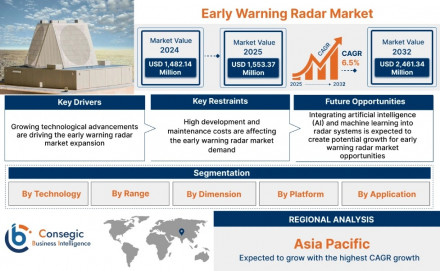Early Warning Radar Market: Analysis and Competitive Landscape (2025-2032)

Early Warning Radar Market Introduction:
Early Warning Radar (EWR) systems are advanced detection systems designed to identify and track incoming threats-such as missiles, aircraft, and ships-at long ranges. These systems are primarily used by defense and military organizations to gain strategic advantages by providing extended reaction time. EWR systems operate using high-frequency radar waves and are often integrated with command and control systems for real-time threat analysis. The increasing frequency of border conflicts, geopolitical tensions, and growing demand for national security have positioned EWR as a crucial component in modern defense infrastructure.
Early Warning Radar Market Overview:
The early warning radar market is experiencing significant growth, primarily driven by the increasing demand for advanced surveillance capabilities and ongoing military modernization efforts. The market encompasses various radar types, including ground-based, airborne, and naval early warning radar systems. Innovations in range, resolution, mobility, and radar signal processing are being accelerated by leading defense contractors and government-supported research and development initiatives.
Early Warning Radar Market Size:
Early Warning Radar Market Size is estimated to reach over USD 2,461.34 Million by 2032 from a value of USD 1,482.14 Million in 2024 and is projected to grow by USD 1,553.37 Million in 2025, growing at a CAGR of 6.5% from 2025 to 2032.
Early Warning Radar Market Includes Drivers, Restraints & Opportunities
Drivers:
- Growing Geopolitical Tensions: Conflicts and border tensions in regions like the Middle East, Eastern Europe, and the Indo-Pacific have led governments to strengthen early detection capabilities.
- Modernization of Defense Systems: Many nations are upgrading their aging radar systems with digital and electronically scanned array radars to enhance threat detection.
- Technological Advancements: Developments in Artificial Intelligence (AI), signal processing, and miniaturization have improved the capabilities and portability of EWR systems.
- Increased Defense Spending: Governments around the world are allocating higher budgets toward national security, with a focus on enhancing surveillance and missile defense systems.
Restraints:
- High Cost of Deployment: EWR systems require significant investment in procurement, installation, and maintenance, which can limit adoption in cost-sensitive regions.
- Technical Complexity: The integration of EWR with other surveillance systems and command networks poses technical challenges.
- Electromagnetic Interference: EWR systems can suffer from signal degradation in densely populated or high-interference environments.
- Export Regulations: Strict regulations and export controls, particularly on military-grade radars, can restrict international sales and limit market expansion.
Opportunities:
- Adoption in Civilian Applications: Beyond military, EWR technology is increasingly being explored for disaster warning systems (e.g., tsunami or hurricane detection).
- Collaborations and Joint Ventures: Defense partnerships between countries and private-public collaborations can help overcome cost and technology barriers.
- Emerging Markets: Nations in Africa, Southeast Asia, and South America are expected to boost procurement as part of broader defense modernization efforts.
- Integration with Satellite Networks: Leveraging satellite and UAV platforms to create integrated EWR networks opens new growth frontiers.
Early Warning Radar Market Competitive Landscape Analysis (Key Players)
- Raytheon (U.S.)
- Thales Group (France)
- BAE Systems (U.K.)
- Northrop Grumman (U.S.)
- General Dynamics (U.S.)
- Saab (Sweden)
- Leonardo (Italy)
- L3Harris Technologies (U.S.)
- Hensoldt (Germany)
- Lockheed Martin (U.S.)
Early Warning Radar Market Industry Segmentation:
By Technology
- Pulse Doppler Radar
- Frequency Modulated Continuous Wave (FMCW) Radar
- Synthetic Aperture Radar (SAR)
- Active Electronically Scanned Array (AESA) Radar
- Others
By Range
- Short Range
- Medium Range
- Long Range
By Dimension
- 2D
- 3D
By Platform
- Airborne Radars
- Land Based Radars
- Naval Radars
- Space Based Radars
By Application
- Air and Missile Defense
- Surveillance and Reconnaissance
- Collision Avoidance
- Critical Infrastructure Protection
- Others
By Region
- Asia-Pacific
- Europe
- North America
- Latin America
- Middle East & Africa
Regional Analysis of the Early Warning Radar Market:
The Early Warning Radar Market exhibits varying growth trends across regions due to differences in defense priorities, budget allocations, and technological advancements.
- North America
- U.S.: Largest market; high defense budget, missile defense focus.
- Canada: Growth via NORAD, Arctic radar projects.
- Mexico: Gradual adoption for airspace/border security.
- Europe
- U.K.: NATO-driven upgrades, carrier radar systems.
- Germany: Boosting air defense, radar modernization.
- France: Investing in autonomous integrated radar systems.
- Spain: Enhancing maritime/air surveillance.
- Italy: Focused on 3D radar, coastal defense.
- Asia-Pacific
- China: Major radar expansion; space-based, OTH systems.
- Japan: Strong radar base; defense-focused deployments.
- India: Indigenous radar tech for border monitoring.
- South Korea: EWR expansion amid regional threats.
- Australia: Indo-Pacific monitoring; radar upgrades.
- Middle East & Africa
- Saudi Arabia: Top buyer; anti-missile EWR systems.
- UAE: Multi-layered radar defenses.
- South Africa: Local radar, coastal surveillance.
- Egypt: Expanding radar for infrastructure security.
- Latin America
- Brazil: Expanding Amazon & defense radar systems.
- Argentina: Radar upgrades for border/coastal security.
- Chile: Stable investment in air/maritime radar.
Early Warning Radar Market Recent Developments:
- 2024: Raytheon announced the deployment of an advanced early warning radar for NATO’s missile defense system in Eastern Europe.
- 2023: India’s DRDO unveiled a new indigenous long-range EWR system capable of detecting aerial threats over 600 km away.
- 2023: Lockheed Martin secured a major contract from the U.S. Air Force to upgrade airborne early warning radar platforms.
- 2022: Leonardo introduced a lightweight, drone-mounted radar system designed for both civil and military early warning applications.
- 2022: Israel Aerospace Industries partnered with several Asian countries for the deployment of multi-layered radar systems amid rising border tensions
Contact us:
Consegic Business intelligence Pvt Ltd.
Contact no: (US) (505) 715-4344
Email: sales@consegicbusinessintelligence.com

